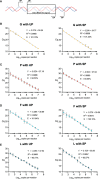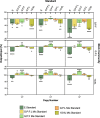A novel Gardnerella, Prevotella, and Lactobacillus standard that improves accuracy in quantifying bacterial burden in vaginal microbial communities
- PMID: 37404722
- PMCID: PMC10315654
- DOI: 10.3389/fcimb.2023.1198113
A novel Gardnerella, Prevotella, and Lactobacillus standard that improves accuracy in quantifying bacterial burden in vaginal microbial communities
Abstract
Bacterial vaginosis (BV) is the most common vaginal dysbiosis. In this condition, a polymicrobial biofilm develops on vaginal epithelial cells. Accurately quantifying the bacterial burden of the BV biofilm is necessary to further our understanding of BV pathogenesis. Historically, the standard for calculating total bacterial burden of the BV biofilm has been based on quantifying Escherichia coli 16S rRNA gene copy number. However, E. coli is improper for measuring the bacterial burden of this unique micro-environment. Here, we propose a novel qPCR standard to quantify bacterial burden in vaginal microbial communities, from an optimal state to a mature BV biofilm. These standards consist of different combinations of vaginal bacteria including three common BV-associated bacteria (BVAB) Gardnerella spp. (G), Prevotella spp. (P), and Fannyhessea spp. (F) and commensal Lactobacillus spp. (L) using the 16S rRNA gene (G:P:F:L, G:P:F, G:P:L and 1G:9L). We compared these standards to the traditional E. coli (E) reference standard using known quantities of mock vaginal communities and 16 vaginal samples from women. The E standard significantly underestimated the copy numbers of the mock communities, and this underestimation was significantly greater at lower copy numbers of these communities. The G:P:L standard was the most accurate across all mock communities and when compared to other mixed vaginal standards. Mixed vaginal standards were further validated with vaginal samples. This new G:P:L standard can be used in BV pathogenesis research to enhance reproducibility and reliability in quantitative measurements of BVAB, spanning from the optimal to non-optimal (including BV) vaginal microbiota.
Keywords: Gardnerella; Lactobacillus; Prevotella; bacterial burden; bacterial vaginosis; biofilm; qPCR standard; vaginal microbiome.
Copyright © 2023 Elnaggar, Ardizzone, Cerca, Toh, Łaniewski, Lillis, Herbst-Kralovetz, Quayle, Muzny and Taylor.
Conflict of interest statement
Author CM is a consultant for Scynexis, Cepheid, and BioNTech. Author CM has received research funding support from NIH/NIAID, Lupin Pharmaceuticals, Abbott Molecular, Visby, and Gilead as well as honoraria from Visby Medical, Elsevier, Abbott Molecular, Scynexis, Roche, and Cepheid. Author RL is the clinical trial site PI for Cepheid, Hologic, Gilead, Visby, Roche, Becton Dickenson, OrthoQuidel, Merck, BioFire, CUE, CovarsaDx, and a consultant for Roche and Cepheid. Author MH-K is on the scientific advisory board for Freya Biosciences and a consultant for Vaginal Biome Sciences. The remaining authors declare that the research was conducted in the absence of any commercial or financial relationships that could be construed as a potential conflict of interest.
Figures



Similar articles
-
Microbial interactions among Gardnerella, Prevotella and Fannyhessea prior to incident bacterial vaginosis: protocol for a prospective, observational study.BMJ Open. 2024 Feb 5;14(2):e083516. doi: 10.1136/bmjopen-2023-083516. BMJ Open. 2024. PMID: 38316599 Free PMC article.
-
Molecular characterization of vaginal microbiota using a new 22-species qRT-PCR test to achieve a relative-abundance and species-based diagnosis of bacterial vaginosis.Front Cell Infect Microbiol. 2024 Jun 28;14:1409774. doi: 10.3389/fcimb.2024.1409774. eCollection 2024. Front Cell Infect Microbiol. 2024. PMID: 39006741 Free PMC article.
-
Composition of the vaginal microbiota in women of reproductive age--sensitive and specific molecular diagnosis of bacterial vaginosis is possible?PLoS One. 2013 Apr 9;8(4):e60670. doi: 10.1371/journal.pone.0060670. Print 2013. PLoS One. 2013. PMID: 23585843 Free PMC article.
-
Characterization of the vaginal microflora in health and disease.Dan Med J. 2014 Apr;61(4):B4830. Dan Med J. 2014. PMID: 24814599 Review.
-
Research Progress on the Correlation Between Gardnerella Typing and Bacterial Vaginosis.Front Cell Infect Microbiol. 2022 Mar 25;12:858155. doi: 10.3389/fcimb.2022.858155. eCollection 2022. Front Cell Infect Microbiol. 2022. PMID: 35402309 Free PMC article. Review.
Cited by
-
Optimized bacterial absolute quantification method by qPCR using an exogenous bacterial culture as a normalization strategy in triple-species BV-like biofilms.J Microbiol Methods. 2024 Apr;219:106895. doi: 10.1016/j.mimet.2024.106895. Epub 2024 Feb 6. J Microbiol Methods. 2024. PMID: 38331102 Free PMC article.
-
Predicting Bacterial Vaginosis Development using Artificial Neural Networks.medRxiv [Preprint]. 2025 May 5:2025.05.02.25326872. doi: 10.1101/2025.05.02.25326872. medRxiv. 2025. PMID: 40385447 Free PMC article. Preprint.
-
Microbial interactions among Gardnerella, Prevotella and Fannyhessea prior to incident bacterial vaginosis: protocol for a prospective, observational study.BMJ Open. 2024 Feb 5;14(2):e083516. doi: 10.1136/bmjopen-2023-083516. BMJ Open. 2024. PMID: 38316599 Free PMC article.
-
Association of Chlamydia trachomatis burden with the vaginal microbiota, bacterial vaginosis, and metronidazole treatment.Front Cell Infect Microbiol. 2023 Dec 12;13:1289449. doi: 10.3389/fcimb.2023.1289449. eCollection 2023. Front Cell Infect Microbiol. 2023. PMID: 38149008 Free PMC article.
-
Molecular characterization of vaginal microbiota using a new 22-species qRT-PCR test to achieve a relative-abundance and species-based diagnosis of bacterial vaginosis.Front Cell Infect Microbiol. 2024 Jun 28;14:1409774. doi: 10.3389/fcimb.2024.1409774. eCollection 2024. Front Cell Infect Microbiol. 2024. PMID: 39006741 Free PMC article.
References
Publication types
MeSH terms
Substances
Grants and funding
LinkOut - more resources
Full Text Sources
Molecular Biology Databases
Miscellaneous

